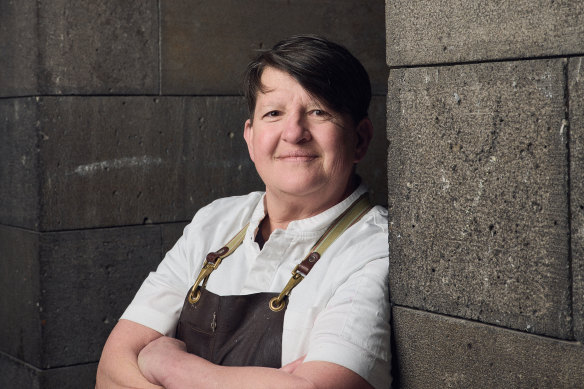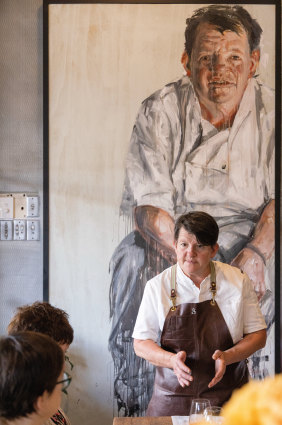This was published 9 months ago
How meeting a famous cook changed my whole relationship to food
By Annie Smithers
The kitchen at Stephanie’s was full of young people all pulling together as a team to create something magical. It was during these years that I first fell in love. I bought a motorcycle and then my first car. I lived in my first share house, grappled with personal finances and started to become the person who I now know so well.
Over time, I became a fully functioning cook, with an incredibly rounded kitchen education, and this foundation has seen me through the last 40 years.

Annie Smithers joined Stephanie’s in 1984 at a time when the Australian dining scene was still young.Credit: Eugene Hyland
In the mid-1980s, I knew very little about food. I was aware that there were a handful of fancy restaurants in Melbourne: Stephanie’s, Glo Glo’s, Fanny’s, Two Faces, and Maria and Walter’s. I had been lucky enough to have been taken to some, never forgetting an entrée of steak tartare with a quail’s egg that I ate at Glo Glo’s in 1982. Those restaurants, and my mother’s interest in entertaining and cookbooks, formed the germs of my knowledge. I knew there was a Julia Child, a Simone (Simca) Beck, an Elizabeth David and a Paul Bocuse, but I didn’t know why they were important. I didn’t know the history behind either the restaurant industry in Australia or abroad: I hadn’t travelled.
I learnt more about these vital things during my apprenticeship, but my friendship with Stephanie marked a turning point in my life. As our friendship developed and my interest in food become broader, Stephanie shared her knowledge and passion with me as we travelled together, ate together and gossiped together.
I am so fortunate to be able to count four decades of friendship with someone who was at the forefront of a formidable restaurant scene in Australia; someone who worked with and studied the French mastery of creating a dining experience back in the 1960s, and was then able to bring that vision back to Australia and set up one of the great fine-dining establishments of its era.
When I joined Stephanie’s in 1984, the restaurant was eight years old. For its first four years it had been ensconced in a building with a shopfront in Fitzroy, but in 1980 it moved to the leafy suburb of Hawthorn. The restaurant I started work at was an extraordinary showpiece of the vision of an incredibly driven woman. Housed in an Italianate mansion, the walls were painted an ox blood-red, while the drapes either side of the large windows were made of heavy velvet in the same colour, with pelmets at the top.
It was a testament to Stephanie’s determination to learn from the great restaurateurs of France and produce her own version.
ANNIE SMITHERS
Each table was dressed in exquisite linen, flatware, glassware and crockery. Sideboards, tapestries and ornate light fittings completed the picture. The scene was one of grand, opulent dining, executed by a brigade of cooks back of house, and a professional, uniformed coterie of waiting professionals who provided the service.
When I look back at the expertise that abounded there, at a time when the Australian dining scene was still young, I am overawed. It was a testament to Stephanie’s determination to learn from the great restaurateurs of France and produce her own version. The kitchen was staffed by imported talent when I arrived, but they were slowly being replaced by locals. While Stephanie directed the show, the head chef was a Frenchman named Alain.

Annie Smithers in front of Daniel Butterworth’s portrait of her, a finalist in the 2016 Archibald Prize.Credit: Simon James
I remember very little from my first weeks there, other than a sense of terror, fatigue and confusion. I knew nothing about working in a team, and I knew almost nothing about cooking. Pretty quickly I learnt about some basics, as Alain was a bit of a shouter. As a new employee, I had come in during a menu cycle so was a bit of an odd-jobs person. My sense of purpose transformed very quickly once the seasonal menu changed, and I was given “a list”. Stephanie’s former training as a librarian meant that she was exceptionally organised. And her knowledge of how a French kitchen worked refined that organisation even further.
My first official position was on the entrée section. Picking parsley, cleaning radishes, clarifying butter, toasting crumbs, picking chervil, buttering coddled egg vessels. These are the very first tasks that build and build and build to create a cook; tasks that I still do today. I now grow the radishes I serve, and each time I pull one from the earth, or wash it and take away the outer leaves, or place it on a plate with a slice of unsalted butter and a small pile of salt, I hear her voice explaining the joy of a radish smeared in the butter, dipped in the salt, with a little rejoinder of, “It’s how the French eat them, Anne.”
By the time the next menu change took place, I felt I had come into my own. I was placed in the pastry room. The system in the kitchen was that each apprentice worked with a more senior colleague, allowing them to be supervised and instructed on a day-to-day basis. The pastry room was a separate space that everyone passed through on their way to the back sinks and coolroom. It was less intense than the main kitchen and only had two full-time inhabitants.
This is possibly where I fell in love with cooking.
Four decades from our first meeting, Stephanie is one of my closest friends. But what that first meeting kindled was a love affair with cooking and restaurants. What I learnt there propelled me out of one universe into another: the torrid, infatuating, adrenaline-rich world of the restaurant kitchen. Everything that you can imagine: the mesmerising skills, the beauty of the raw ingredient, the spats, the showdowns, the discipline. A world of endless silver polishing, plate stacking and sauce warming. Everything except the bullying and the useless shouting. There was no time or place for that at Cato Street.
What was it that ignited the fire? First, it was the woman herself. Stephanie not only has a great love of European food, but has always been a keen student of the great restaurants and chefs of France during the 1960s and ’70s, and what made them great. These ideals were transformed into her dream of the great restaurant that she presided over. With that knowledge came an incredibly structured kitchen. I still recall many of the dishes and much of the produce.
The restaurant was all-consuming; I lived and breathed it day after day, week after week. There was always an element of fear, of not being good enough, of not doing a job well enough, but the fear kept you on a knife’s edge. Stephanie was ever-present in the kitchen, guiding, teaching, extolling. The immersion into that world of passion was addictive. I have never lost it, the love of the process. The sum of a restaurant’s parts. The glassware, the napery, the crockery, the discipline, the order, the produce, the wine – the list goes on. There are so many things to love about the restaurant industry. I recognise the cook that I am in that kitchen of Stephanie’s. Not only had I found what I was, but I had found my people. That dedicated, crazy bunch who are consumed by all things restaurant.
I often ruminate that if you picked up my little Lyonville farm and placed it in rural France, it would work admirably. My connection to seasonality, terroir and preservation techniques all originate from that kitchen back in Cato Street. Pastry techniques, custard techniques. The joy of veal stock. The wonder of duck fat. Poultry, game and meat. Seafood and dairy. Things from the earth, grown and plucked with love and care. A nod to traditional techniques without besmirching modern ways. The growing of food, the cooking of it and the serving of it. Stephanie Alexander didn’t just teach me how to cook, she taught me how to love food.
Edited extract from Kitchen Sentimental (Thames & Hudson) by Annie Smithers, out now.
Get the best of Sunday Life magazine delivered to your inbox every Sunday morning. Sign up here for our free newsletter.